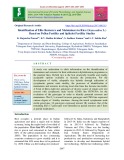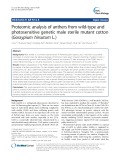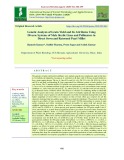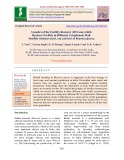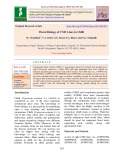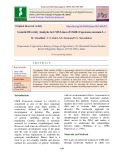
Cytoplasmic genetic male sterility
-
Ebook "Progress in botany 67" provides readers with contents including: fascination with chloroplasts and chromosome pairing; recombination - cytoplasmic male sterility and fertility restoration in higher plants; function of genetic material - from genomics to functional markers in maize; extranuclear inheritance - gene transfer out of plastids; molecular cell biology - epigenetic gene silencing in plants;...
 583p
583p  tachieuhoa
tachieuhoa
 28-01-2024
28-01-2024
 5
5
 2
2
 Download
Download
-
Cytoplasmic male sterility (CMS) is a maternally inherited inability to produce functional pollen found in numerous flowering plant species. CMS is associated with mitochondrial DNA mutation, novel chimeric open reading frames (ORFs), and rearrangement of coding and noncoding regions of the mitochondrial genome.
 10p
10p  vinarcissa
vinarcissa
 21-03-2023
21-03-2023
 2
2
 1
1
 Download
Download
-
The objective of research "Identification of SNP markers linked to Rf locus in carrot using GBS" was to identify SNP markers linked to Rf locus and develop a genetic map of Rf gene in carrot. For this purpose, a carrot F2 population segregating for male sterility was produced and segregating 10,425 SNP markers were discovered by using genotyping by sequencing (GBS).
 15p
15p  lyhuyenthu
lyhuyenthu
 31-01-2023
31-01-2023
 7
7
 1
1
 Download
Download
-
The genus Brassica mainly comprises three diploid and three recently derived allotetraploid species, most of which are highly important vegetable, oil or ornamental crops cultivated worldwide. Despite being extensively studied, the origination of B. napus and certain detailed interspecific relationships within Brassica genus remains undetermined and somewhere confused.
 15p
15p  vijeeni2711
vijeeni2711
 24-07-2021
24-07-2021
 14
14
 0
0
 Download
Download
-
Cotton is an important fiber crop but has serious heterosis effects, and cytoplasmic male sterility (CMS) is the major cause of heterosis in plants. However, to the best of our knowledge, no studies have investigated CMS Yamian A in cotton with the genetic background of Australian wild Gossypium bickii. Conjoint transcriptomic and proteomic analysis was first performed between Yamian A and its maintainer Yamian B.
 17p
17p  vijeeni2711
vijeeni2711
 30-06-2021
30-06-2021
 13
13
 1
1
 Download
Download
-
In the present study, cytoplasmic male sterility derived from A2 cytoplasm of pigeonpea was combined with four leaf type agronomic backgrounds by using backcrossing programme These four leaf shapes were recessive in the expression against lanceolatus leaf shape. These naked eye polymorphic (NEP) markers will be useful for maintaining purity of hybrid seeds if coupled with cytoplasmic male sterility hence present investigation was conducted.
 11p
11p  cothumenhmong9
cothumenhmong9
 18-01-2021
18-01-2021
 21
21
 1
1
 Download
Download
-
There is a need to diversify CMS lines and restorer lines in different genetic background to create some variation and utilize them in hybrid breeding. Present research efforts were made to enhance the variability in CMS lines through conversion of dwarf four lines viz., Dwarf 30 cm, Dwarf 45 cm, Dwarf 60 cm and Dwarf 90 cm into cytoplasmic male sterility. Variation in the height of the parents will help in identifying the out crossed seeds from CMS and selfed-seeds from the hybrid populations.
 10p
10p  cothumenhmong9
cothumenhmong9
 18-01-2021
18-01-2021
 10
10
 1
1
 Download
Download
-
A study was undertaken to elicit information on the identification of maintainers and restorers for their utilization in hybridization programme as the parental lines. Hybrid rice is the best practically feasible and readily acceptable options available to increase the production. For the development of viable, adoptable rice hybrids through utilization of cytoplasmic genetic male sterility, the processes of identification of maintainers and restorers involving local elite lines has become inevitable.
 5p
5p  angicungduoc8
angicungduoc8
 07-11-2020
07-11-2020
 13
13
 1
1
 Download
Download
-
A set of 27 pearl millet (Pennisetum glaucum (L.) R. Br.] ) hybrids that newly developed using A1 cytoplasmic male-sterile lines, were evaluated over three (two wet and one dry) crop seasons (hereafter refer to as environments) in Randomized Complete Block Design (RCBD) with two replications to predict genotype by environment (G × E) interaction for grain yield and its component traits, and to identify the high yielding stable hybrids through AMMI and cluster analysis method for possible adaption. Analysis of variance showed significant genetic variation for all studied traits exists.
 12p
12p  nguaconbaynhay6
nguaconbaynhay6
 24-06-2020
24-06-2020
 15
15
 0
0
 Download
Download
-
Male sterility is a common phenomenon in flowering plant species, and it has been successfully developed in several crops by taking advantage of heterosis. Using space mutation breeding of upland cotton, a novel photosensitive genetic male sterile (PGMS) mutant was isolated.
 16p
16p  viminato2711
viminato2711
 22-05-2020
22-05-2020
 7
7
 0
0
 Download
Download
-
The genetics of grain yield and its attributes were studied using diverse cytoplasmic male sterile lines in 144 hybrids developed by crossing six A- and their six B-lines with 12 R-lines of pearl millet in a line x tester mating design. The six A- lines 81A1 and 8A1 (A1 ), Pb 313A (A2 ), Pb 402A (A3 ), 81A4 and 81A5 and their corresponding B- lines represented five different systems of male sterility were very diverse.
 14p
14p  chauchaungayxua4
chauchaungayxua4
 18-03-2020
18-03-2020
 25
25
 1
1
 Download
Download
-
Hybrid breeding in Brassica juncea is suggested as the best strategy to boost rape seed mustard production in India. Diversified male sterile and restorer lines are required for a strong sustainable hybrid breeding programme. Knowledge about the inheritance of male sterile and restorer genes are essential for this. We studied the genetics of fertility restorer gene which can restore the fertility in three different male sterile systems(mori, eru and ber)in B.juncea using nine different BC1F1 populations.
 9p
9p  caygaocaolon3
caygaocaolon3
 09-03-2020
09-03-2020
 12
12
 0
0
 Download
Download
-
Cytoplasmic Male sterility (CMS) is increasingly utilized for hybrid seed production of chilli (Capsicum annuum L.). Eight CMS and eight maintainer lines were studied for different morphological characters and pollen sterility. The CMS lines viz., AVPP0711S, AVPP0709S, AVPP0710S, AVPP0309S and AVPP0310S were found to be most sterile. It has been concluded that wide range of genetic variability existed for the different floral biological and morphological characters which could be utilized for systematic exploration in chilli improvement programme through hybridization.
 7p
7p  chauchaungayxua3
chauchaungayxua3
 07-02-2020
07-02-2020
 8
8
 0
0
 Download
Download
-
Cytoplasmic Male sterility (CMS) is increasingly utilized for hybrid seed production of chilli (Capsicum annuum L.). Eight CMS and eight maintainer lines were studied for genetic diversity using ISSR markers. The ISSR analysis revealed substantial polymorphism in chilli. The results of the present study indicated the efficiency of ISSR markers in investigating genetic variability at molecular level, which is important for detecting variation of different genotypes of chilli and its utilization for further breeding programme.
 6p
6p  chauchaungayxua3
chauchaungayxua3
 07-02-2020
07-02-2020
 12
12
 0
0
 Download
Download
-
Cytoplasmic-genic male sterile based F1 hybrid is a revolutionary approach to break yield stagnation in pigeonpea. Hybrid vigor is positively correlated to genetic distance and allelic divergence of the parents. This study estimated genetic divergence of 8 ‘A’ lines, 2 ‘B’ lines and 19 ‘R’ lines of A2 and A4 cytoplasmic sources, and predicted best parental combinations using molecular markers. Among 390 EST-SSR markers screened, only 60 markers found polymorphic indicating very low degree of polymorphism (15.4%). Average allelic count was 2.26 with a range of 2-4 per loci. Mean PIC was 0.
 12p
12p  cothumenhmong1
cothumenhmong1
 10-12-2019
10-12-2019
 14
14
 1
1
 Download
Download
CHỦ ĐỀ BẠN MUỐN TÌM









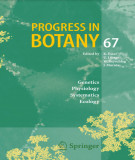
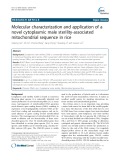

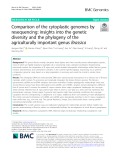

![Exploitation of the leaf variants in CGMS system derived from A2 cytoplasm in pigeonpea [Cajanus cajan (L.) Millsp.] Exploitation of the leaf variants in CGMS system derived from A2 cytoplasm in pigeonpea [Cajanus cajan (L.) Millsp.]](https://tailieu.vn/image/document/thumbnail/2021/20210118/cothumenhmong9/135x160/151610934475.jpg)
![Utilization of different height variant alleles in CGMS system derived from A2 cytoplasm in pigeonpea [Cajanus cajan (L.) Millsp] Utilization of different height variant alleles in CGMS system derived from A2 cytoplasm in pigeonpea [Cajanus cajan (L.) Millsp]](https://tailieu.vn/image/document/thumbnail/2021/20210118/cothumenhmong9/135x160/2111610934473.jpg)
